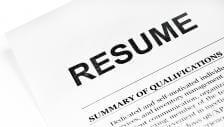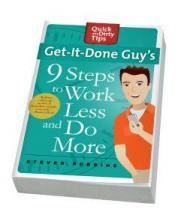How to Write a Great Resume (Part 2)
Writing a great resume means having a great flow to what you present and the order you present it. In Part 2 of this series, Get-It-Done Guy explans how to craft a resume that will get you the job.

Sponsor: Get more things done with your team: get your free 30-day premium subscription of Wrike now.
Today, we’re going to plunge into the mysterious thicket of the resume organization itself.
People Don’t Read From Start to Finish
Imagine a hiring manager named Bo. Bo is a busy person who needs to find someone who can be an insanely great team member, think outside the box when necessary, and be content in what is largely going to be a rote, meaningless job devoid of challenge, excitement, or any real substance. There’s a stack of 50 resumes on the desk, and only 10 minutes to read them all, because what hiring manager actually plans their day to include enough time for recruiting-related tasks? If you want that job, your resume must immediately say, “Bo? Bo…You really want to meet me! Give me a call. Let’s do lunch.”
Bo is going to scan the resumes. Scanning isn’t reading. Scanning is looking at the job titles, the first few words of the first few bullet points, and deciding whether this resume can be disqualified or not. Only if the resume passes the scan will it get read in detail. Your resume must seduce, and must do it by scanning.
Use a Summary, Not an Objective
Let’s start at the top. Many people include an “Objective” section. Objectives do not seduce. Your resume tells the story of how you’ll help them, not the story of what you want. Bo doesn’t care what your objective is. Sad, but true. So don’t include it. If you want a powerful lead-in section to your resume (maybe because you have to fill some extra white space), include a “Summary” section, with the three or four points you want them to remember about why their life will be so much better with you in it. Then the rest of your resume gives evidence of that fact. ‘
Here’s a sample summary:
“I’ll expand your company into new markets. My negotiating skills will help you get better terms from your vendors across the board, and they’ll thank you for it. Teams get more done when I’m on them. Cars run faster and cleaner. Light bulbs require less power when I’m in the room. And with me on your team, you can lose weight without going to the gym, eating nothing but Oreo Ice Cream cake.”
Who wouldn’t want to call this person in for an interview?
Don’t Overemphasize Your School

The one exception is if you have awe-inspiring credentials like degrees from MIT and Harvard in which case, that’s all you put on your resume, along with the words, “WORSHIP ME!!” in a big, bold font. Use several exclamation points. You won’t get the job, but your ego will feel much better about the $350,000 worth of tuition you’ll be paying back until you’re 85.
Your Resume Organization Tells a Story
Traditionally, resumes list all your jobs, most recent first. That organization doesn’t really tell a story, though, except “tThis person is now older than they used to be.” Readers often ignore your earlier jobs, under the theory that if you did it a while ago, you couldn’t possibly still be good at it. That’s kind of bizarre, since the truth may be that you’re now expert at it. Regardless, early career accomplishments get short shrift in a chronological ordering.
Gaps on a chronological resume stand out and invite awkward questions (“What’s this two-year gap?” “Well, I had a job. I dressed up as a giant purple hot dog. I don’t like to talk about it. It wasn’t a proud moment.”)
Functional Resumes Let You Control the Story

Include sections corresponding to your major skill sets, or major results you can deliver. List detailed experience there. For example, under “Sales Experience,” list your time selling memberships in fractional jet rentals and that time you set up a lemonade stand with your best friend in 3rd grade. That way, older experience can still be part of the story showing you have awesome skills. Indeed, it can even be used to tell the story that this skill is one that spans a lifetime. (As well as a misdemeanor indictment for selling victuals without a license, but you don’t need to include that detail on the resume.)
If you choose a functional organization, you may still want to include a bottom section listing employers and job titles. This turns your resume into a “combined” resume that gives the interviewer both a skill-based impression of you and a big picture summary of where you’ve worked. Whether or not you decide to do a combined resume depends on whether or not it supports the story you want to tell. Google “functional resume” for many, many examples..
Verify the Story
Whether you choose a chronological or functional approach, have a friend read the resume when you think you’re done with it. Tell them the company you’re applying for, the problems you believe that company has, and ask them “If you were a hiring manager, would you call this person in for an interview? Why?” Don’t ask them if it’s a good resume; dozens of good resumes get discarded. Don’t ask them if it makes you look good; everyone’s resume makes them look good. You want to know if the story your resume tells is one that will make Bo pause and think “This just could be the answer to our problems,” and put you in the “Bring this person in!” pile.

I’m Stever Robbins. I help high-achievers create extraordinary lives, careers, and businesses. If you want to know more, visit SteverRobbins.com.
Work Less, Do More, and have a Great Life!
Diploma and other images courtesy of Shutterstock.






